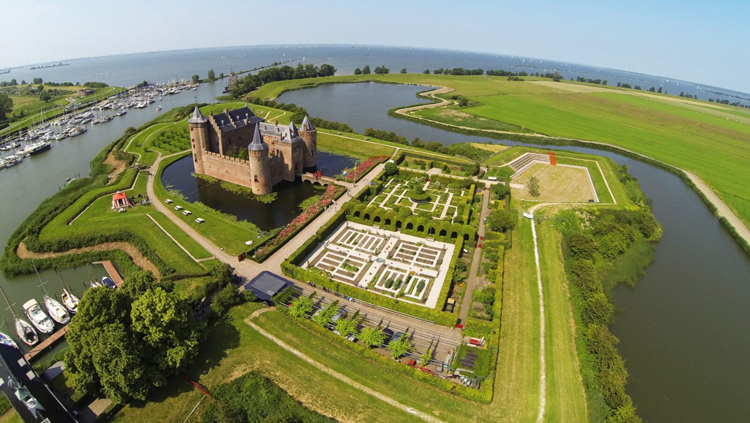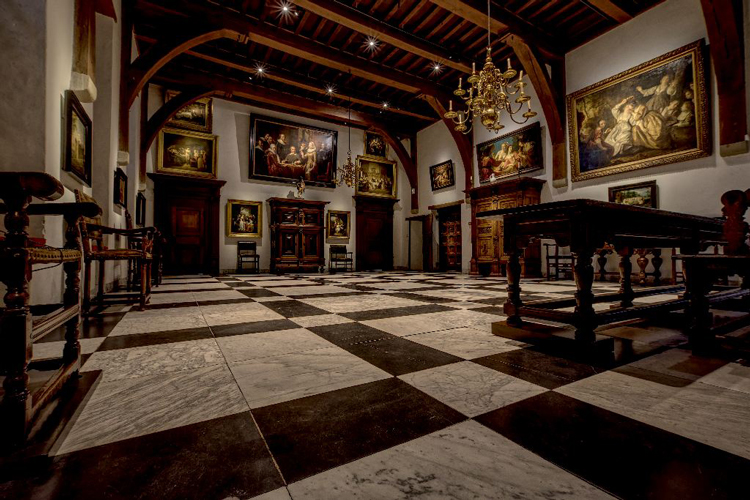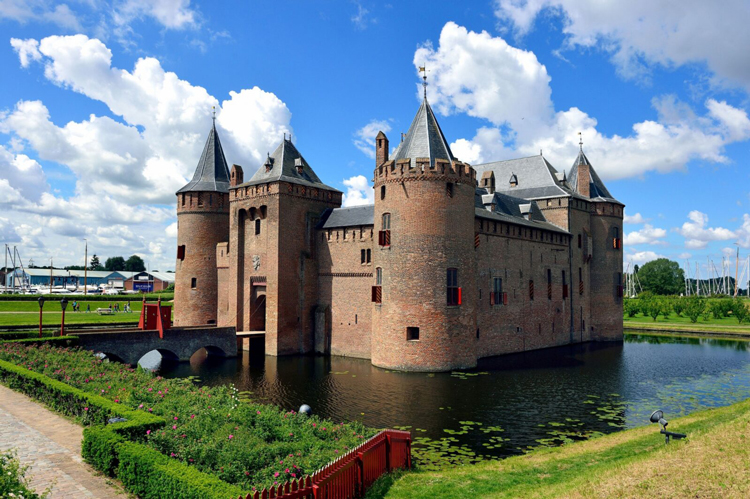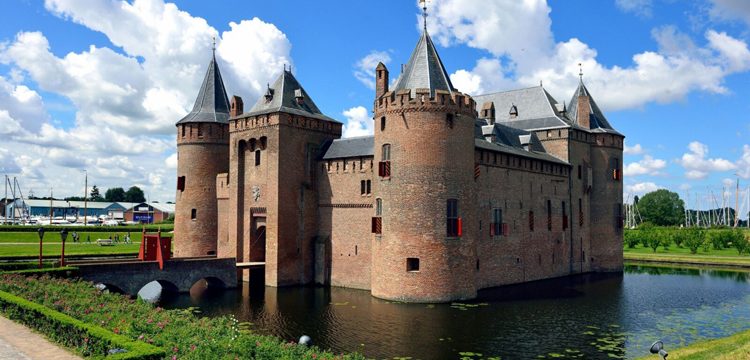Not far from the bustling city of Amsterdam, nestled for over 700 years, lies the picturesque Muiderslot, commonly known as Amsterdam Castle. Surrounded by water and enchanting castle gardens, it stands as one of the oldest and best-preserved castles in the Netherlands. This article delves into the rich history and captivating features of this remarkable castle. Discover in this article all the information about visiting Amsterdam Castle. A fun activity for the whole family and a unique experience to enjoy in the Netherlands!

The Oldest Water Castle in the Netherlands
Amsterdam Castle proudly holds the distinction of being the oldest water castle in the Netherlands. A defining feature of a water castle is its foundation partially submerged in water, which served as a practical defense mechanism. When an enemy approached, the drawbridge would be raised, effectively blocking access across the castle’s moat.
A Castle steeped in history
Built in 1285, Muiderslot was originally constructed for one primary purpose: defense. Throughout its storied history, the castle has seen a myriad of uses, from being occupied and inhabited to almost facing demolition. However, in 1878, it was rescued from the brink of destruction, thanks to the intervention of King Willem I. Under the skilled guidance of architect Pierre Cuypers, known for his work on iconic landmarks like Amsterdam’s Central Station and the Rijksmuseum, the castle was meticulously restored.
Visitors to Muiderslot have the unique opportunity to step back in time and immerse themselves in medieval and 17th-century life. The castle’s interior showcases a treasure trove of artifacts, including knights’ armor, swords, everyday objects, furniture, paintings, sculptures, and more. These artifacts provide a window into the past, offering a glimpse of what life was like within the castle’s walls during different eras.
The Enchanting Gardens
The Muiderslot gardens, dating back to the 17th century, are a testament to both aesthetics and practicality. In an age when having a readily available food source was crucial, these gardens served a dual purpose – they were not only a source of beauty but also sustenance. Today, they continue to be a serene haven for relaxation and enjoyment.
What sets the Muiderslot gardens apart is their unique collection of “living heritage.” These gardens serve as a sanctuary for forgotten and endangered historical flowers and plant species. This collection changes with the seasons and offers visitors a sensory experience, with the opportunity to see, touch, and even taste these heritage plants. The design of the gardens closely mirrors the one created by Pieter Corneliszoon Hooft, the most famous resident of Muiderslot, during the early 17th century.
The gardens are divided into two sections by a lush, overgrown arbor, or “berceau.” On one side lies the “Kruydhof,” where kitchen herbs and herbs for medicinal or dye-making purposes thrive. On the other side is the “Warmoeshof,” the vegetable garden, essential for self-sufficiency during the 17th century. Notably, this garden also embraces new vegetables introduced through trade, such as artichokes, tomatoes, and maize, all cultivated in the same organic manner employed in the 17th century, without artificial fertilizers or pesticides.

A Fortress within a Fortress
The Muiderslot gardens are nestled within a military fortress, which dates back to the 17th century when fortifications were constructed. Trees atop the fortress walls served both to strengthen the earthen ramparts and to shield against harsh coastal winds from the former Zuiderzee.
Dense bramble bushes on the walls acted as barriers to potential attackers, while leafy trees concealed the fortress from view, both from the water and the surrounding landscape. Remarkably, the Muiderslot fortress is also part of the UNESCO World Heritage-listed Stelling van Amsterdam, a defensive line designed to protect the Dutch capital.
Exploring Amsterdam Castle
For those eager to explore the castle further, Muiderslot offers an engaging audio tour. This tour provides fascinating insights into the castle’s construction history, defense strategies, daily life within its walls, and the captivating gardens. The audio tour is available in multiple languages and is suitable for visitors of all ages.

Visiting Muiderslot
Muiderslot welcomes visitors during both the summer and winter months. From April 1st to October 31st, the castle is open every day from 10 AM to 5 PM.
During the winter season, from November 1st to March 31st, Muiderslot is open from Tuesday to Sunday. Additionally, the castle remains open on all public holidays and vacation days.
Getting to the Amsterdam Castle
Accessing Muiderslot is convenient via public transportation. Visitors can take a train from either Amsterdam Centraal or Utrecht Centraal to Weesp, followed by a short bus ride (bus 110) to the Muiden Centrum bus stop. From there, it’s just a 10-minute walk to the castle. Alternatively, buses from Amsterdam Amstelstation and Amsterdam Bijlmer ArenA also provide access to Muiden.

Amsterdam Castle Amenities
While exploring Muiderslot, don’t forget to visit the museum shop, located on the castle grounds. Here, you can find an array of charming souvenirs and gifts related to Muiderslot, its gardens, and castle life.
Additionally, the museum café offers a delightful selection of food and beverages, including warm and cold drinks, sweet treats, lunch options, and snacks. It’s the perfect place to relax and indulge in delicious, fresh products.
Special Experiences for Children
Muiderslot offers a unique experience for younger visitors. The Torenroute (Tower Route) features a special audio tour designed for kids, offering insights into the lives of knights and the castle’s defense. Additionally, children aged 6 to 11 can embark on a captivating treasure hunt throughout the castle, complete with fun tasks and the opportunity to create a paper model of Muiderslot.

Discover the Waterschild Pavilion
Behind Muiderslot lies the Waterschild Pavilion, an underground exhibit that reveals the story of the water surrounding the castle. Learn whether water was a friend or foe to the castle’s defenses and challenge yourself to cross the waterscreen.
Strategic location
The choice of Muiderslot’s location was no accident. Positioned by the water, the castle served as a strategic point for trade, situated along the former Zuiderzee and the Vecht River.
All passing ships were required to pay tolls at Muiderslot, contributing to its financial prosperity over the centuries.

